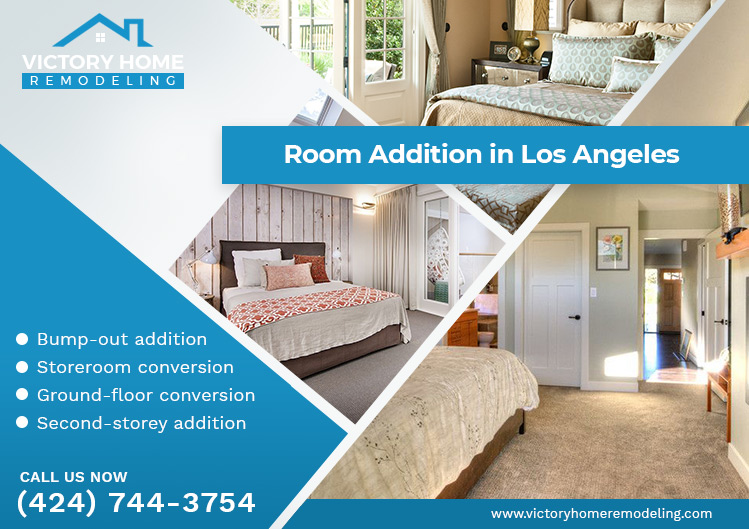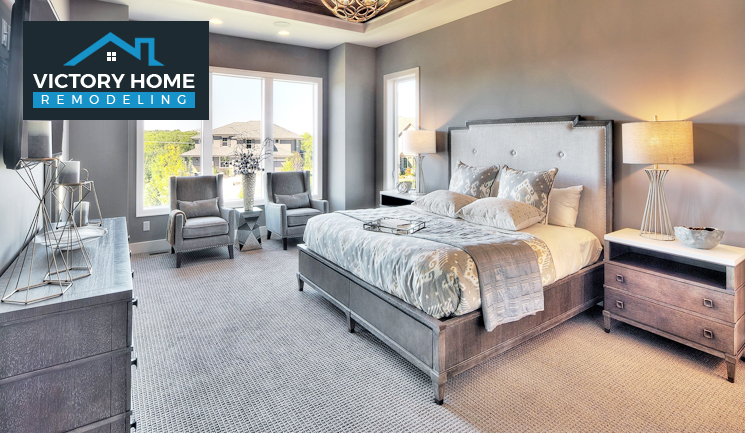Room additions in home remodeling allow homeowners to customize and enhance their living spaces. These additions come in a wide variety, ranging from modest to extensive, and can significantly improve the functionality and value of the home. Let’s explore the different types of room additions frequently implemented by homeowners.
Bump Outs
Bump outs are a minor room addition where a new space is “bumped out” from an existing wall of your home. This type of addition is ideal for enhancing a particular room’s space without needing a full-scale home addition.
Conventional Home Addition
A traditional home addition typically entails constructing a multi-room adjacent to your home. This type of addition is commonly employed to provide substantial extra space, such as adding a new bedroom and bathroom combination.
Sunroom Addition
A sunroom addition is an outdoor living room made of glass and screen, which can be installed on a concrete or wood foundation. It provides a cost-effective means of expanding your living space and increasing the amount of natural light in your home.
Conversion Addition
This refers to transforming underutilized spaces such as basements or attics into functional living areas. This approach offers a brilliant opportunity to maximize the efficient utilization of existing space, enhancing functionality and livability.
Second Story Addition
Adding a second story to your home entails creating an entirely new level. Though this undertaking is substantial, it has the potential to double your living area and enhance the value of your property.
Kitchen & Dining Room Addition
For a kitchen and dining room addition, new space is added to the house specifically for expanding the kitchen and dining area. This is an excellent option for enhancing their home’s culinary space.
Family Room Addition
Family room additions are designed to provide additional space for relaxation and entertainment, making the home more welcoming and comfortable for family members and guests. These thoughtful additions enhance the ambiance and create an inviting atmosphere to enjoy quality time with loved ones.
Bathroom Addition
Installing an additional bathroom in your residence offers not only convenience but also has the potential to enhance the value of your property substantially. A well-designed bathroom addition can also add a touch of luxury and sophistication to your home.
Garage Addition
A garage addition can serve multiple purposes, providing extra storage space, a place for vehicles, or even a new living area if the garage is attached to the home and adequately insulated. This type of addition is an excellent way to add value and functionality to your home.
Adding a room to your home is a gratifying but complex task. It involves meticulous planning and execution to ensure the project succeeds and meets the required standards. A typical room addition process involves several essential steps to ensure the project proceeds smoothly, efficiently, and within the set timelines.
First Meeting
The process starts with an initial meeting where the homeowners and the contractors discuss the details of the project. During this meeting, various aspects, such as the purpose of the addition, the design preferences, the budget, and the timeline, are discussed in detail.
Estimate & Design
After understanding the homeowner’s requirements, the contractors provide an estimated cost for the project. They also work on designing the room addition using professional design software, ensuring the new addition blends seamlessly with the existing structure.
Room Addition Permit
Obtaining the necessary permits is a crucial step in the room addition process. The contractors usually handle this step, ensuring all the plans comply with the local building codes and regulations.
The range of required permits for a room addition in Los Angeles can vary significantly based on the project’s scope, location, and complexity. It’s essential to comply with local building codes and regulations, ensuring the safety and legality of the construction.
Typically, these permits may encompass general building, electrical, plumbing, and mechanical permits. Each of these permits serves a distinct purpose: building permits ensure the structural integrity of the addition, electrical permits validate the safety of wiring installations, plumbing permits verify the appropriateness of water and sewage connections, and mechanical permits cover installations like heating and cooling systems.
Work Begins
Once the permits have been secured, the construction work for the room addition can begin. This phase involves site preparation, foundation laying, framing, roof, doors, and windows installation.
- Build the Foundation: The foundation forms the base of the new room and is vital for stability. Depending on the type of addition, this could involve digging and laying down a concrete slab or constructing a crawlspace or full basement.
- Frame the Structure: Framing is the step where the room takes shape. This involves constructing the skeleton of the room, including the walls, floor, and ceiling, using heavy-duty materials like wood or steel.
- Add the Sheathing and Roofing: Sheathing, or wall and roof cladding, is applied over the frame to provide a firm, flat surface for the exterior siding and roofing. Once this is in place, roofing materials are installed to protect against weather and outside elements.
- Install Windows and Doors: Windows and doors are critical elements offering function and character to the room. They are carefully installed in pre-determined frame openings to ensure a proper fit, providing light, ventilation, and access to the room.
- Rough-In Electrical, Plumbing, and HVAC: The rough-in phase involves the installation of the room’s electrical wiring, plumbing lines, and HVAC ductwork. This step is crucial for setting up the essential services needed for a fully functional room.
- Add Insulation and Drywall: Insulation is added to the walls, floors, and ceiling to enhance the room’s energy efficiency and comfort. After the insulation is installed, drywall panels are fitted, forming the smooth walls of the room’s interior.
- Finish the Interior: This phase involves the installation of trim, painting, flooring installation, and other finishes. During this phase, the room’s design and aesthetics come together.
- Make Fixture Connections: Fixture connections include installing light fixtures, outlets, switches, sinks, toilets, and other fixtures. This step helps to finalize the room’s functionality and usability.
- Complete the Landscaping: Any external work, including landscaping and exterior detailing, such as painting or siding, is completed. This final step helps to enhance the exterior look of the new addition and tie it in with the existing home’s design.
Scheduling Inspection
The inspection process forms an integral part of the room addition project, ensuring that all aspects of the renovation adhere to the safety standards, building codes, and the approved plans. Typically, three essential inspections occur at different stages of the project: the rough-in inspection, the second inspection, and the final inspection.
- Rough-In Inspection: The rough-in inspection is crucial after installing framing, plumbing, electrical, and HVAC systems. It ensures proper installation of concealed systems behind walls per building codes and safety standards.
- Second Inspection: The second inspection occurs after insulation installation but before adding drywall. It ensures proper insulation installation and compliance with energy code requirements. It also allows for rectifying any issues before concealing the insulation with drywall.
- Final Inspection: The final inspection is conducted after completing the project. It examines the room addition’s structural integrity, electrical systems, plumbing, HVAC, and finishes. A successful final inspection indicates compliance with codes, safety standards, and readiness for use.











